Human Resources for Health Observer
The WHO-supported regional health workforce observatories are cooperative mechanisms, through which health workforce stakeholders share experiences, information and evidence to inform and strengthen policy decision-making. The Human Resources for Health Observer series makes available the latest findings and research from different observatories to the widest possible audience.
The series covers a wide range of technical issues, in a variety of formats, including case studies, reports of consultations, surveys, and analysis. In cases where information has been produced in local languages, an English translation – or digest – will be made available.
2025
2023
What the COVID-19 pandemic has exposed: the findings of five global health workforce...
2022
Tool to assess impact of human resources for health investments on HIV, TB and malaria...
2021
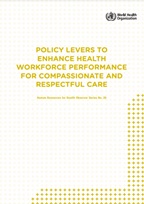
Policy levers to enhance health workforce performance for compassionate and respectful...
2020
What do we know about community health workers? A systematic review of existing reviews
Community health workers (CHWs) are health care providers who live in the community they serve and receive lower levels of formal education and training...
The World Health Organization’s (WHO) 2010 Increasing access to health workers in remote and rural areas through improved retention: global policy...
2019
Delivered by women, led by men: A gender and equity analysis of the global health and social workforce...
The report, produced by the WHO Global Health Workforce Network’s Gender Equity Hub, co chaired by WHO, and Women in Global Health, is the latest...
2018
2017
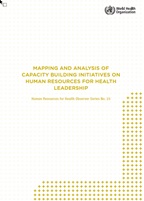
Mapping and analysis of capacity building initiatives on human resources for health...
Optimizing the contributions of the nursing and midwifery workforce to achieve universal health coverage...
The nursing and midwifery professions have been recognized for their crucial role in implementing the priorities envisaged in the Millennium Development...
Mapping educational opportunities and resources for health-care workers to learn about antimicrobial...
Antimicrobial resistance (AMR) is a looming global health problem; misuse and overuse of antimicrobials over the past 50 years has accelerated the development...
Health workforce and labour market dynamics in OECD high-income countries: a synthesis of recent analyses...
The backbone of any health-care system is the human resources who deliver care. Thus, human resources for health (HRH) planning has a direct impact on...
The World Health Organization (WHO) has a long history of supporting the nursing and midwifery workforce through the provision of technical assistance,...
2016
Health workforce requirements for universal health coverage and the Sustainable Development Goals
Health systems can only function with health workers; improving health service coverage and health outcomes depends on a fit-forpurpose and fit-to-practise...
The health workforce in India
This study on the health workforce is based on data at district level from the Indian census of 2001. The census of India 2001 canvassed information on...
Workload indicators of staffing need (WISN): selected country implementation experiences
Since the launch of the computerised version of the Workload Indicators of Staffing Need (WISN) tool in 2010, many countries have implemented WISN studies...
2014
2013
Interprofessional education case study
Interprofessional Collaborative Practice in Primary Health Care: Nursing and Midwifery...
2012
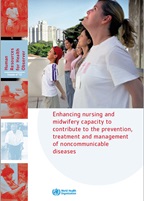
Enhancing nursing and midwifery capacity to contribute to the prevention, treatment and management of...
The global burden of noncommunicable diseases is already high and continues to grow in all regions of the world. Given this trend, it is important to scale...
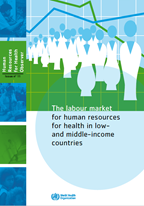
The labour market for human resources for health in low- and middle-income countries (Human Resources...
All low- and middle-income countries (LMIC) have health worker labour markets. Some of these countries’ markets function better than others and all...
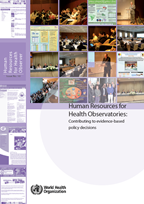
Human Resources for Health Observatories: Contributing to evidence-based policy decisions
The critical importance of strengthening the health workforce as a strategy to improve the performance of health services system has been widely recognized...
Health workforce governance and leadership capacity in the African Region Review of human resources for...
Health workforce governance or leadership capacity at national level and all other levels is considered fundamental in order to steer the health workforce...
2011
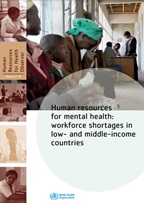
Human resources for mental health: workforce shortages in low- and middle-income countries
Mental, neurological and substance use (MNS) disorders account for an estimated 14% of the global burden of disease, yet mental health routinely receives...
Efficiency and effectiveness of aid flows towards health workforce development - Exploratory study based...
Over the last decade, it has become increasingly clear that the health workforce deficit is an important obstacle to achieving the Millennium Development...
Policies and practices of countries that are experiencing a crisis in human resources for health: tracking...
In order to understand and monitor the progress in developing and implementing HRH policies in the 57 countries experiencing a critical deficit in the...
2010
Policies and practices of countries that are experiencing a crisis in human resources for health: tracking...
In order to understand and monitor the progress in developing and implementing HRH policies in the 57 countries experiencing a critical deficit in the...
Measuring health workforce inequalities: methods and application to China and India is for users and producers of quantitative data in support of decision-making...
Many low- and middle-income countries face acute shortages and maldistribution of skilled health workers, impeding the likelihood of meeting health systems...
The formulation of national human resources for health (HRH) policies and strategies requires evidence-based planning to rationalize decisions. A range...
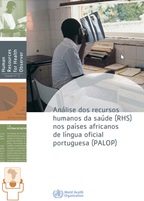
The report provides available data on the health workforce in Portuguese speaking countries (PALOP). Its purpose is to support the responsible staff and...
